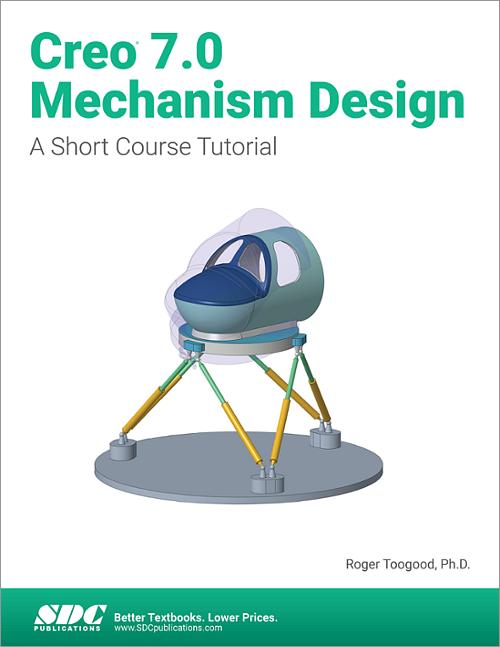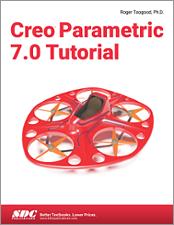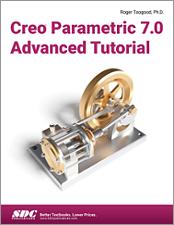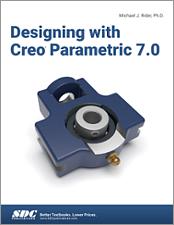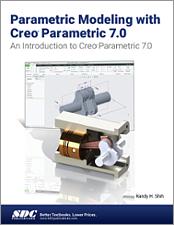Creo 7.0 Mechanism Design
A Short Course Tutorial
- Description
- Contents
- Downloads
- Details
Description
Key Features
- Learn to simulate the performance of your designs without costly prototypes
- Addresses all the essential tools of mechanism design with Creo
- Guides you through the assembly and analysis of a slider-crank mechanism
- Describes types of simple and special connections, servos, and motor functions
- Allows you to learn the basics of mechanism design in about two hours
In Detail
Creo 7.0 Mechanism Design Tutorial neatly encapsulates what you need to know about the essential tools and features of Mechanism Design with Creo: how to set up models, define analyses, and display and review results. If you have a working knowledge of Creo Parametric in Assembly mode, this short but substantial tutorial is for you. You will learn to create kinematic models of 2D and 3D mechanisms by using special assembly connections, define motion drivers, set up and run simulations, and display and critically review results in a variety of formats. This includes creating graphs of important results as well as space claim and interference analyses. Common issues that arise during mechanism design are briefly addressed and extra references listed so you can work through them when encountered.
In Detail
If you ever need to model a device where parts and subassemblies can move relative to each other, you will want to use the world-renowned mechanism functions in Creo. Creo’s Mechanism Design functions allow you to examine the kinematic properties of your device: range of motion and motion envelopes, potential interference between moving bodies, and kinematic relationships (position, velocity, acceleration) between bodies for prescribed motions. With these functions, you will better predict the actual performance of the device and create design improvements without the expense of costly prototypes, saving you time, money and worry.
With this tutorial, you will assemble and analyze a simple slider-crank mechanism. Each chapter has a clear focus that follows the workflow sequence, and parts are provided for the exercise that include creating connections, servos, and analyses. This is followed by graph plotting, collision detection, and motion envelope creation. You can choose to quickly cover all the essential operations of mechanism design in about two hours by following the steps covered at the beginning of chapters 2-5, or you can complete the full chapters or come back to them as needed. Plenty of figures, screenshots and animations help facilitate understanding of parts and concepts.
Once you have completed chapters 2-5 and the slider-crank mechanism, chapter 6 familiarizes you with special connections in Mechanism Design: gears (spur gears, worm gears, rack and pinion), cams, and belt drives. The final chapter presents a number of increasingly complex models (for which parts are provided) that you can assemble and use to explore the functions and capability of Mechanism Design in more depth. These examples, including an In-line Reciprocator, Variable Pitch Propeller and Stewart Platform, explore all the major topics covered in the book.
Topics Covered
- Connections: cylinder, slider, pin, bearing, planar, ball, gimbal, slot, rigid/weld, general
- Servos and motor function types: ramp, cosine, parabolic, polynomial, cycloidal, table, user defined
- Tools for viewing analysis results: trace curve, motion envelope, user defined measures, animations, collision/interference detection; analysis problems
- Special connections: spur gear, worm gear, rack and pinion, cams and belts
Table of Contents
- Introduction to Creo Mechanism Design
- Making Connections
- Creating Motion Drivers
- Setting up and Running an Analysis
- Tools for Viewing Results
- Special Connections
- Exercises
List of Animations
Downloads
For additional information on downloading, unzipping, and using these files visit the downloads section on our FAQ page.
Product Details
| Publisher | SDC Publications |
| Authors | Roger Toogood Ph.D. |
| Published | March 29, 2021 |
| User Level | Intermediate |
| Pages | 78 |
| Binding | Paperback |
| Printing | Black and White |
| Print ISBN | 978-1-63057-452-9 |
| Print ISBN 10 | 163057452X |
| eBook ISBN | 978-1-63056-651-7 |
